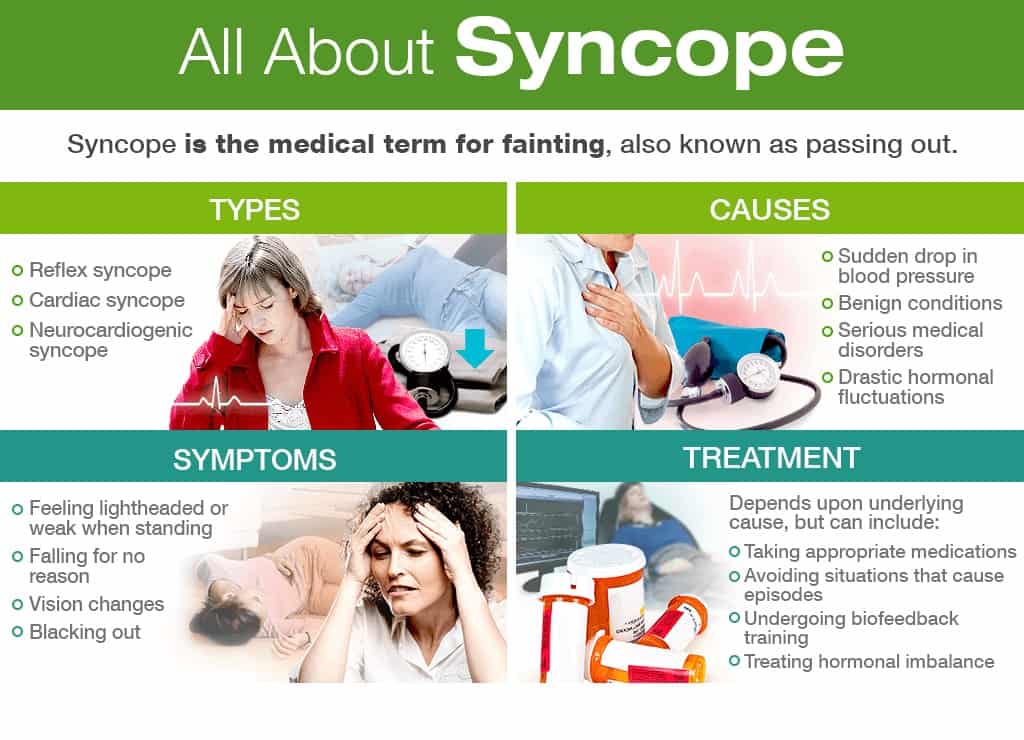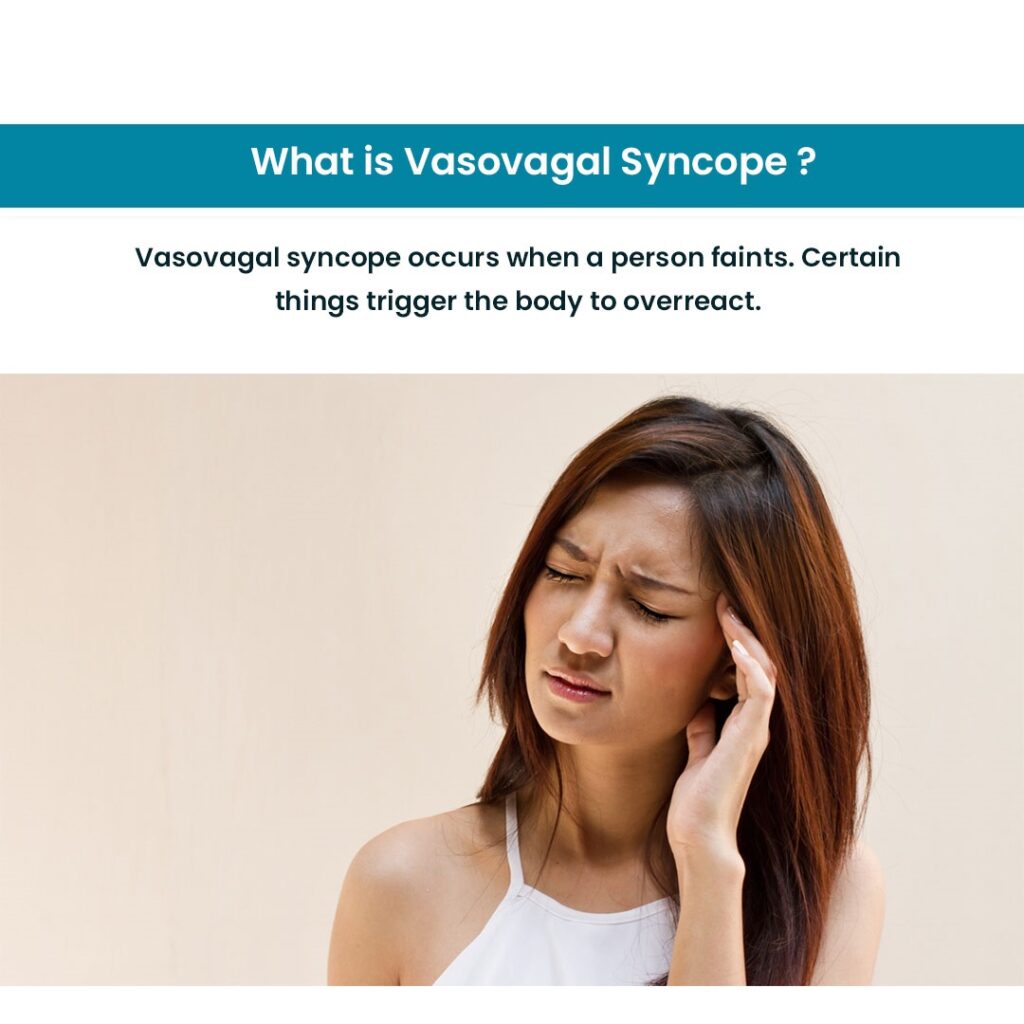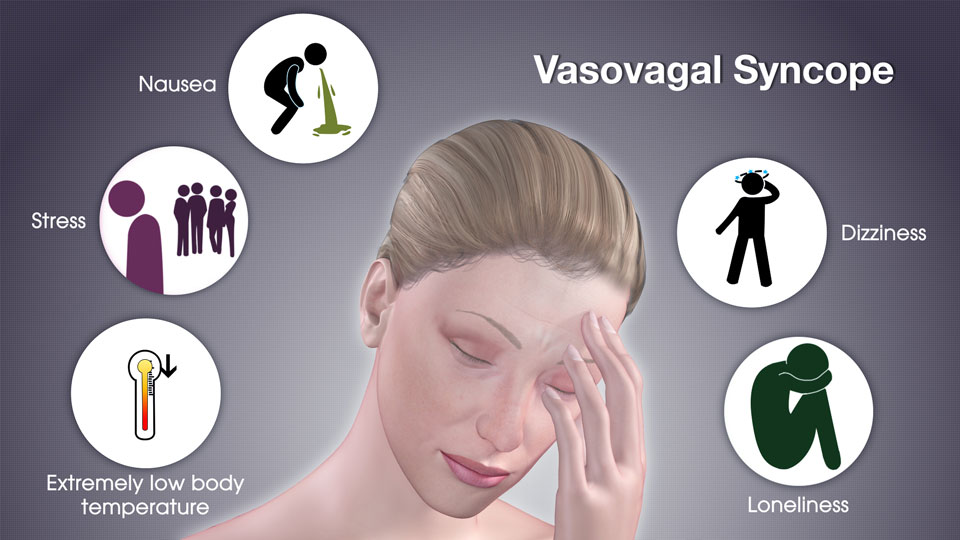WHAT IS VASOVAGAL SYNCOPE?
Vasovagal syncope happens when you faint because your body overreacts to specific triggers, like the sight of blood or extreme emotional distress. It might also be called neurocardiogenic syncope.
The vasovagal syncope trigger causes your heart rate and blood pressure to drop unexpectedly. That leads to decreased blood flow to your brain, causing you to briefly lose consciousness.
Vasovagal syncope is generally harmless and needs no treatment. But it is possible that you might injure yourself during a vasovagal syncope episode. Your doctor might recommend tests to rule out more-severe causes of fainting, like heart disorders.

SYMPTOMS
Before you faint because of vasovagal syncope, you might experience some of the following:
- Pale skin
- Light-headedness
- Tunnel vision — your field of vision decreases so that you see only what’s in front of you
- Nausea
- Feeling warm
- A cold, clammy sweat
- Blurred vision
During a vasovagal syncope episode, bystanders might notice:
- Jerky, abnormal movements
- A slow, weak pulse
- Dilated pupils
Recovery after a vasovagal episode usually starts in less than a minute. However, if you stand up too soon after fainting — within about fifteen to thirty minutes — you are at risk of fainting again.
WHEN SHOULD YOU SEE A DOCTOR?
Fainting could be a sign of a more severe condition, like a heart or brain disorder. You might want to consult your doctor after a fainting spell, particularly if you have never had one before.

CAUSES
Vasovagal syncope happens when the part of your nervous system that regulates heart rate and blood pressure malfunctions in response to a trigger, like the sight of blood.
Your heart rate slows down, and the blood vessels in your legs widen (dilate). This enables blood to pool in your legs, which lowers your blood pressure. Combined, the drop in blood pressure and slowed heart rate quickly decrease blood flow to your brain, and you faint.
Sometimes there is no classical vasovagal syncope trigger, but common triggers are:
- Standing for long periods of time
- Heat exposure
- Seeing blood
- Having blood drawn
- Fear of bodily injury
- Straining, like having a bowel movement
PREVENTION
You might not always be able to avoid a vasovagal syncope episode. If you feel like you may faint, lie down and lift your legs. This enables gravity to keep blood flowing to your brain. If you cannot lie down, sit down and put your head between your knees till you feel better.
DIAGNOSIS
Diagnosing vasovagal syncope often starts with a physical exam. During the physical examination, your doctor will listen to your heart and take your blood pressure. He or she might also massage the main arteries in your neck to see if that causes you to feel faint.
Your doctor might also recommend several tests to rule out other possible causes of your fainting — especially heart-related problems. These tests might include:
- Electrocardiogram – This test records the electrical signals your heart generates. It could detect irregular heart rhythms and other cardiac problems. You might need to wear a portable monitor for at least a day or as long as a month.
- Echocardiogram – This test uses ultrasound imaging to view the heart and look for conditions, like valve problems, that could cause fainting.
- Exercise stress test – This test studies heart rhythms during the exercise. It is generally conducted while you walk or jog on a treadmill.
- Blood tests – Your doctor might look for conditions, like anemia, that could cause or contribute to fainting spells.
- Tilt table test – If no heart problems appear to cause your fainting, your doctor might recommend that you undergo a tilt table test. During the test, you lie down flat on your back on a table that changes positions, tilting you upward at various angles. A technician examines your heart rhythms and blood pressure during the test to see if changing your posture affects them.

TREATMENT
In most cases of vasovagal syncope, treatment is not required. Your doctor might help you identify your fainting triggers and discuss ways you may avoid them.
However, if you experience vasovagal syncope often enough to interfere with your quality of life, your doctor might recommend trying one or more of the following remedies:
- Medications – A drug known as fludrocortisone acetate that is normally used to treat low blood pressure might be helpful in preventing vasovagal syncope. Selective serotonin reuptake inhibitors also might be used.
- Therapies – Your doctor might recommend ways to decrease the pooling of blood in your legs. These might include foot exercises, wearing compression stockings, or tensing your leg muscles when standing. You might need to increase salt in your diet if you do not usually have high blood pressure. Avoid prolonged standing — particularly in hot, crowded places — and drink plenty of fluids.
- Surgery – Very rarely, inserting an electrical pacemaker to regulate the heartbeat might help some people with vasovagal syncope who have not been helped by other treatments.
If you or anyone you know is suffering from vasovagal syncope, our expert providers at Specialty Care Clinics will take care of your health and help you recover.
Call us on (469) 545-9983 to book an appointment with our specialists.
